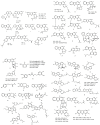Phytochemistry and Biological Activities of Murraya Species
- PMID: 37570872
- PMCID: PMC10421387
- DOI: 10.3390/molecules28155901
Phytochemistry and Biological Activities of Murraya Species
Abstract
Murraya is a plant genus within the Rutaceae family comprising over 17 species, which are widely distributed in Asia, Australia, and the Pacific Islands. Furthermore, these species have been used in traditional medicine to treat fever, pain, and dysentery. Several reports have also extensively studied the leaves, seeds, stembark, and bark of Murraya from 1965 to 2023 to explore their natural product composition. Various phytochemical studies have revealed the isolation of 413 compounds recorded, comprising coumarins, terpenoids, flavonoids, and aromatics, as well as alkaloids, which constitute the largest proportion (46.9%). These isolated compounds have long been known to exhibit different bioactivities, such as cytotoxic and anti-inflammatory properties. Cytotoxic activity has been observed against HCT 116, HeLa, HepG2, and other cell lines. Previous studies have also reported the presence of antifungal, hepatoprotective, antihyperlipidemic, antidiarrheal, and antioxidant effects. Therefore, this review provides a comprehensive overview of Murraya species, highlighting their phytochemistry, biological activities, and potential as a source of active natural compounds.
Keywords: Murraya; Rutaceae; phytochemistry; secondary metabolites.
Conflict of interest statement
The authors declare no conflict of interest.
Figures














Similar articles
-
Ethnobotanical uses, phytochemistry and pharmacology of pantropical genus Zanthoxylum L. (Rutaceae): An update.J Ethnopharmacol. 2023 Mar 1;303:115895. doi: 10.1016/j.jep.2022.115895. Epub 2022 Dec 10. J Ethnopharmacol. 2023. PMID: 36513263 Review.
-
Phytochemistry and pharmacognosy of the genus Acronychia.Phytochemistry. 2013 Nov;95:12-8. doi: 10.1016/j.phytochem.2013.07.013. Epub 2013 Aug 3. Phytochemistry. 2013. PMID: 23920228 Review.
-
The Genus Haplophyllum Juss.: Phytochemistry and Bioactivities-A Review.Molecules. 2021 Jul 31;26(15):4664. doi: 10.3390/molecules26154664. Molecules. 2021. PMID: 34361817 Free PMC article. Review.
-
Phytochemistry and pharmacology of the genus Drypetes: A review.J Ethnopharmacol. 2016 Aug 22;190:328-53. doi: 10.1016/j.jep.2016.06.060. Epub 2016 Jun 25. J Ethnopharmacol. 2016. PMID: 27353868 Review.
-
Review on the genus Brugmansia: Traditional usage, phytochemistry, pharmacology, and toxicity.J Ethnopharmacol. 2021 Oct 28;279:113910. doi: 10.1016/j.jep.2021.113910. Epub 2021 Feb 8. J Ethnopharmacol. 2021. PMID: 33571613 Review.
Cited by
-
An Innovative Approach for Biocontrol of Meloidogyne incognita in Ginger Using Potential Bacteria Isolated from Indian Himalayas.Curr Microbiol. 2023 Oct 20;80(12):381. doi: 10.1007/s00284-023-03496-6. Curr Microbiol. 2023. PMID: 37864042
References
-
- Wilson A. Flora of Australia Volume 26 Meliaceae, Rutaceae, Zygophyllaceae. ABRS Canberra/CSIRO Publishing; Melbourne, Australia: 2013. pp. 501–503.
-
- Ma X.L., Zhu S.S., Liu Y., Chen H.W., Shi Y.T., Zeng K.W., Tu P.F. Carbazole alkaloids with potential cytotoxic activities targeted on PCK2 protein from Murraya microphylla. Bioorganic Chem. 2021;114:105–113. - PubMed
-
- Wei R., Ma Q., Zhong G., Su Y., Yang J., Wang A., Ji T., Guo H., Wang M., Jiang P., et al. Structural characterization, hepatoprotective and antihyperlipidemic activities of alkaloid derivatives from Murraya koenigii. Phytochem. Lett. 2020;35:135–140. doi: 10.1016/j.phytol.2019.11.001. - DOI
Publication types
MeSH terms
Substances
Grants and funding
LinkOut - more resources
Full Text Sources

